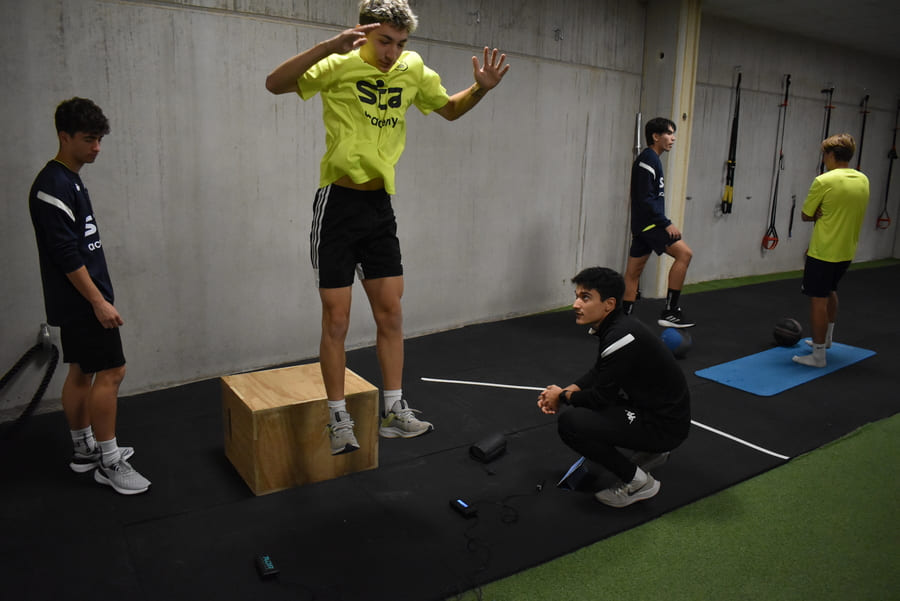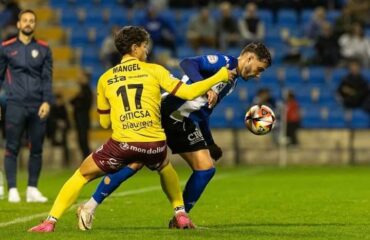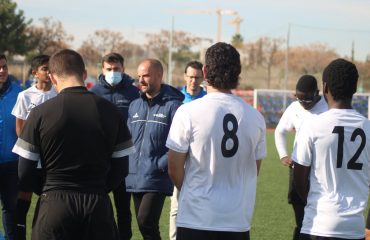Physical recovery after a football match is essential for the optimal performance of players. The intensity and demands of a match can cause significant muscle wear and general fatigue. SIA Academy has adopted a multidimensional approach to physical recovery, providing players with the necessary tools to handle this process effectively and safely. This article explores the physical recovery strategies implemented by SIA Academy and how they help footballers maintain their competitive level.
Table of contents
The physical wear of football
Football is a high-intensity sport that requires explosive efforts, quick changes of direction, jumps, and continuous endurance work. The physical effort a footballer exerts during a match can leave a toll on their muscles, joints, and cardiovascular system. Footballers experience what is known as muscle fatigue, which can lead to muscle micro-injuries if not properly managed.
The main goal of recovery is to restore the body’s homeostasis, that is, to bring back the physical balance that is lost after physical exertion. This process not only focuses on the physical aspect but also on the mental one, as football is a sport that requires high levels of concentration and psychological endurance.

Recovery methods at SIA Academy
At SIA Academy, recovery is not a singular or linear process. Several techniques based on scientific studies and practical experience are employed to ensure each player recovers effectively. Below are some of the most important methods.
1. Post-match nutrition: the key to muscle recovery
Nutrition plays a crucial role in the recovery of footballers. After a match, players need to replenish both the nutrients and electrolytes lost during exertion. SIA Academy provides its players with a nutrition plan tailored to their specific needs.
- Carbohydrates: Help replenish glycogen levels, which are depleted during the match.
- Proteins: Are essential for muscle repair and tissue rebuilding.
- Healthy fats and micronutrients: Aid in cellular recovery and immune system strengthening.
A well-designed nutrition plan ensures the body has all the necessary nutrients for optimal recovery.
2. Rehydration: fluid replacement
Football is a sport that causes significant fluid loss due to physical exertion and sweating. Rehydration is essential to restore the balance of water and electrolytes in the body. SIA Academy promotes the consumption of isotonic drinks, which help recover lost electrolytes such as sodium and potassium, assisting in muscle function and preventing cramps.
In addition to isotonic drinks, water is also essential to ensure fluids are properly absorbed by the body.
3. Massage and manual therapies: relief and muscle recovery
Sports massages are one of the most commonly used techniques at SIA Academy to relieve muscle tension after matches. Massages increase blood flow and help eliminate accumulated toxins in the muscles.
- Reduction of inflammation: The massage technique, when applied correctly, can reduce inflammation and improve muscle elasticity.
- Injury prevention: By releasing accumulated tension in the muscles, massages help prevent future injuries.
The work of physiotherapists is crucial in customizing the treatment according to each player’s individual needs.

4. Cold and heat therapies: alternation for complete recovery
Alternating cold and heat is another commonly used technique at SIA Academy. Cold is used to reduce inflammation and relieve pain, while heat promotes blood circulation and relaxes muscles. Both techniques are essential for speeding up recovery and reducing stiffness.
- Ice baths: Help reduce muscle inflammation and post-match pain.
- Hot compresses: Promote circulation and reduce muscle stiffness.
5. Stretching and joint mobility: injury prevention
Post-match stretching is essential for maintaining muscle flexibility and preventing injuries. At SIA Academy, footballers perform a stretching routine aimed at relaxing tense muscles and improving range of motion. In addition to stretching, joint mobility work improves the range of motion of the joints, which is crucial for maintaining agility and preventing long-term injuries.
- Static and dynamic stretching: Help reduce muscle stiffness.
- Joint mobility: Prevents injuries and enhances performance in future training and matches.
6. Regenerative training: light activity for active recovery
While rest is essential, regenerative training plays an important role in the recovery process. SIA Academy incorporates low-intensity exercises, such as light jogging or stationary bike sessions, to maintain blood circulation without subjecting the body to excessive strain.
This type of activity helps eliminate byproducts of physical exertion, such as lactic acid, and improves overall recovery without putting additional stress on the body.
7. Rest and sleep: mental and physical restoration
Rest is one of the pillars of recovery, both physically and mentally. Deep sleep allows for muscle regeneration and restoration of the central nervous system. At SIA Academy, players are educated on the importance of sleeping between 7 and 9 hours each night, as sleep is when the body recovers most effectively.
Additionally, mental rest is just as important, as stress accumulated during a match can affect the player’s overall well-being.
Final keys to physical recovery
Physical recovery is an essential process for success in professional football, and SIA Academy has integrated a series of strategies that enable footballers to maintain their performance level after an intense match. From nutrition and hydration to massages and cold and heat therapy, each of these elements plays a crucial role in the process. The combination of these techniques allows players to recover holistically, both physically and mentally, which is key to their ongoing development and success on the field.
By applying these practices, footballers can optimize their performance, reduce the risk of injury, and extend their careers. SIA Academy demonstrates that proper recovery is not only crucial for the players’ health but also for their long-term success.






